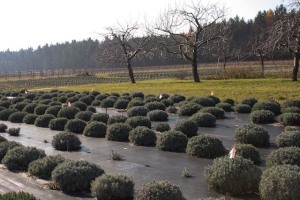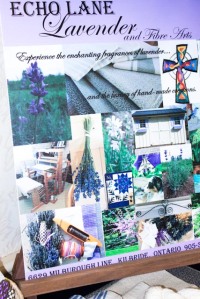In November 2012, I traveled to Canada to speak at the Ontario Lavender Conference. During this two-day gathering, I discovered a vibrant, inspiring and collaborative community of lavender enthusiasts.
Ontario’s lavender industry grew out of a small study group formed in 2003. Later in 2010, it blossomed into the Ontario Lavender Association. During this time, Ontario’s farmers were seeing a shift impacting farming opportunities.
- Tobacco, which had been Southern Ontario’s leading horticultural cash crop, diminished. Demand plummeted due to health concerns, cigarette taxes and new government policies. In 1970, 3,000 farms grew tobacco in Canada; today the number has dropped to about 650.
- Fruit orchards, burdened with high labor costs, struggled to compete with growers around the world. Prices dropped and income dwindled.
- Raising hogs no longer supplied enough revenue to cover costs.
The situation was clear. Some families who had farmed their land for generations needed to cultivate new crops. Farmers transitioned into various horticultural crops including grapes, a wide range of vegetables and other fruit crops. Some Ontario farmers shifted to growing lavender.
These farmers imagined a new industry. One that would use lavender in an array of value-added products such as soap, shampoo and seasonings, and at the same time attract tourists to visit their lavender fields during the summer bloom. Revenue would come from farm boutiques, tours and on-line shops. However, before purchasing and planting thousands of lavender plants, the growers wanted to feel confident that their plants would survive Ontario’s cold winters.
To discover which kinds could survive the winter, a trial tested 27 varieties at six sites in southern Ontario. Additional testing would evaluate lavender varieties to rate their visual beauty, oil quality and content and bloom time, for example how many weeks the bloom endures.
Chaired by Anita Buehner, who is co-owner of Bonnieheath Lavender, the Ontario Lavender Association obtained a research grant from the Sand Plains Community Development Fund. The money would fund research to find suitable lavender varieties for Ontario’s growing conditions. Growers who hosted the trials paid the cost of the plants; and the University of Guelph, the Ontario Ministry of Agriculture, Food and Rural Affairs (OMAFRA) and Erie Innovation and Commercialization provided support. Growers, government ministries, industry associations and academia, all worked together to launch Ontario’s lavender industry.
Research will continue for three years. Additional funding came from OMAFRA New Directions Research Fund. A detailed report summarized the findings related to the survivability of lavender varieties. This report is available on the Ontario Lavender Association’s. According to the report, “…lavandins did not survive as well as angustifolias.” and “The highest rated angustifolias were Folgate, Betty’s Blue, and Blue River ….”
The Ontario Lavender Association now has 25 members, and in November 2012, hosted its first Ontario Lavender Conference. Jan Schooley, owner of Apple Hill Lavender, and Dr. Sean Westerveld, Ontario Ministry of Agriculture, Food and Rural Affairs, co-chaired the event. The agenda focused on “The Business of Lavender.”
Seventy-four people went to the conference. Attendees included growers, artisans, and research professionals. Most participants came from Canada; however several growers traveled from Michigan, New York and Pennsylvania to learn about Ontario’s lavender experience. Mary Tate Bergstrom represented the United States Lavender Growers Association.
When I read about a banquet with “lavender-inspired culinary delights,” I was intrigued. Lavender played a leading role in the menu. Green salad served with savory dressing demonstrated lavender’s ability to accentuate the fresh flavor of vegetables. The main course, chicken, mashed potatoes and cauliflower, combined many flavors. Herbes de Provence, a blend of herbs such as lavender, rosemary, basil and thyme, seasoned the potatoes perfectly. The finale, mixed berry trifle with lavender-infused cream, silenced the room as diners relished the flavor.
Pat Earls, an Ontario Lavender Association member and owner of Lavenders of Norfolk, created the recipes, and the chef received kudos for his preparation. This banquet not only exceeded my expectations, it provided positive proof of lavender’s culinary versatility. (Thank you to Pat Earls for sharing her recipes and giving me permission to share them on my blog: Lavender Salad Dressing, Herbes de Provence Mashed Potatoes and Lavender Berry Trifle.
After dinner I gave the keynote presentation, “Lavender Business Models from around the World.” Farms I featured included:Ali’i Kula Lavender, Bridestowe Estate, White Oak Lavender Farm, Forest Green Man Lavender, and Becker Vineyards. Each of these farms exemplifies successful agri-tourism strategies.
The next morning I talked about the culinary connection. My topic was how to use culinary lavender to stir up profits. As a foodie, I especially like to discuss flavor combinations. This presentation generated a good discussion. Questions ranged from “Can lavender stems be used in cooking?” to “Have you experimented with hydrosol to flavor food?” I can’t wait to try these ideas, and when I do, I will post the results on my blog.
On the drive to the airport for my flight back to Seattle, I felt honored to have been a speaker at this event. I’d met new lavender growers, and I was inspired by their resilience and enthusiasm. I don’t know whether lavender will replace the income lost from tobacco, fruit and hogs; however I do know the Ontario growers will transform their region into purple fields of lavender in the summer season.
I am already planning my return to Ontario; but my next trip will be in summer when lavender will be in full bloom.

























